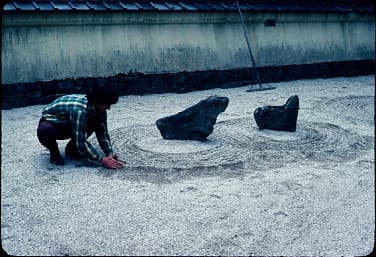
Inspired in the late 1950s by growing cultural ties between Oregon and Japan, Mayor Terry Schrunk and members of the Portland community conceived the idea of building a Japanese garden on the site of the old zoo in Washington Park. Their reasons for building a Japanese garden were twofold: providing the citizens of Portland with a garden of great beauty and serenity, while forging a healing connection to Japan on the heels of World War II. At this time in U.S. history, Japanese gardens were founded across the country as a way to build cultural understanding. Needing no translation, an American could experience firsthand Japanese ideals and values, communicated simply through nature.
The site was dedicated in 1961, and Professor Takuma Tono of Tokyo Agricultural University was retained to design the Garden. Professor Tono’s plan included five different garden styles laid out on 5.5 acres. This was quite a departure from gardens in Japan which typically follow one singular style. His intention was to represent different historical developments in Japanese garden architecture and through that communicate Japanese culture to create a cultural exchange.
In 1967, the Garden formally opened to the public for the summer. Admission was $0.50 for adults and $0.25 for students. That year, more than 28,000 people came before the Garden closed for the winter.

In 1968, the Kashintei Tea House was constructed in Japan, shipped in pieces, and reassembled in the Garden. Other structures were added as the five gardens evolved. The Pavilion Gallery, which sits at the heart of the Flat Garden, was in Professor Tono’s original plan. However, it was not completed until 1980. (Interestingly, it was dedicated on May 18 – the same day that Mount St. Helens erupted.)
It was not until the winter of 1981/1982 that Portland Japanese Garden was first kept open year round. In 2015, the Garden partnered with world renowned architect Kengo Kuma as it embarked on a new journey, expanding its footprint to accommodate its rapid visitor growth, as well as its ability to immerse visitors in Japanese arts and culture. The Garden’s new Cultural Village features three new structures, each LEED-certified, existing harmoniously with nature and serving as a mere frame from which to view the exquisite beauty of the surrounding landscape. The new Cultural Village opened in April 2017.
Throughout the Garden’s history, it has been acclaimed by a number of visiting Japanese dignitaries as one of the most beautiful and authentic Japanese gardens in the world outside of the island nation, as well as one of the foremost Japanese cultural organizations in North America.
All of us associated with this inspiring project feel that the Japanese Garden in Washington Park will add another gem in Portland’s crown. Not only will it enhance the tourist appeal of our city, but it will serve to strengthen the close bonds that already exist between our peoples.
Mayor Terry Schrunk (1957-1973) and US Senator Mark Hatfield (1967-1997)